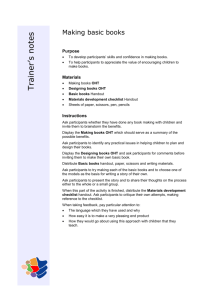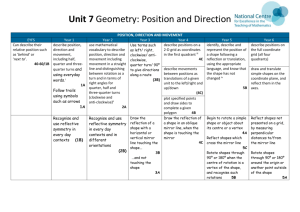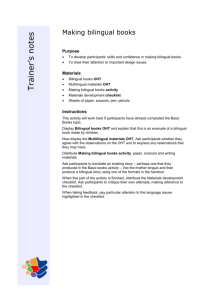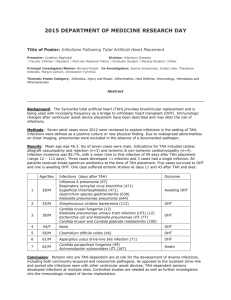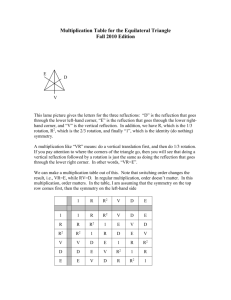Unit 5b - The Dudley Grid For Learning
advertisement
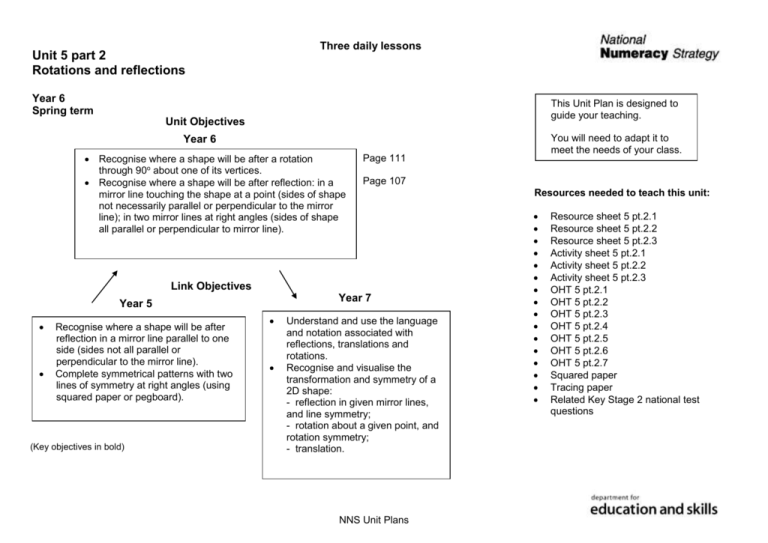
Three daily lessons Unit 5 part 2 Rotations and reflections Year 6 Spring term This Unit Plan is designed to guide your teaching. Unit Objectives You will need to adapt it to meet the needs of your class. Year 6 Recognise where a shape will be after a rotation through 90o about one of its vertices. Recognise where a shape will be after reflection: in a mirror line touching the shape at a point (sides of shape not necessarily parallel or perpendicular to the mirror line); in two mirror lines at right angles (sides of shape all parallel or perpendicular to mirror line). Page 111 Page 107 Link Objectives Year 7 Year 5 Recognise where a shape will be after reflection in a mirror line parallel to one side (sides not all parallel or perpendicular to the mirror line). Complete symmetrical patterns with two lines of symmetry at right angles (using squared paper or pegboard). (Key objectives in bold) Understand and use the language and notation associated with reflections, translations and rotations. Recognise and visualise the transformation and symmetry of a 2D shape: - reflection in given mirror lines, and line symmetry; - rotation about a given point, and rotation symmetry; - translation. NNS Unit Plans Resources needed to teach this unit: Resource sheet 5 pt.2.1 Resource sheet 5 pt.2.2 Resource sheet 5 pt.2.3 Activity sheet 5 pt.2.1 Activity sheet 5 pt.2.2 Activity sheet 5 pt.2.3 OHT 5 pt.2.1 OHT 5 pt.2.2 OHT 5 pt.2.3 OHT 5 pt.2.4 OHT 5 pt.2.5 OHT 5 pt.2.6 OHT 5 pt.2.7 Squared paper Tracing paper Related Key Stage 2 national test questions Planning Day One sheet Oral and Mental Unit 5 pt.2 Rotations and reflections Objectives and Vocabulary Objectives and Vocabulary Count up and back in steps of 9 and 90. Teaching Activities Use vocabulary associated with rotation. Children count up in 9s and then back to zero. Term: Spring Year Group: 6 Main Teaching Recognise where a shape will be after 90 degrees rotation about a vertex. Q What is a good strategy for counting up in 9s? Plenary Teaching Activities Teaching Activities/Focus Questions Show OHT 5pt.2.1. Using each of the triangles in turn, demonstrate rotation of a triangle through 90 degrees, clockwise and anticlockwise, about each of its vertices. Each time identify the centre of rotation, and emphasise the angle and direction. Ask children to come out and show various rotations. Demonstrate rotations of 180 and 270 degrees. Identify the increase in the 10s and the decrease in the units, e.g. 27 to 36. Show OHT 5 pt.2.3. Say you want to rotate the trapezium about the origin through 90 degrees, anticlockwise. Q Where will A be after the rotation? What position will B, C and D take? Get children to draw where the points move to and where the shape will be after the rotation. Q What is a 90 degrees clockwise rotation followed by a 90 degree clockwise rotation equivalent to? Children count up in 90s. Establish other equivalences and the effect of a clockwise rotation followed by an anticlockwise rotation. Make the link to counting up in 90 degrees. Show OHT 5 pt.2.2. Using the same two triangles rotate about the origin, e.g. Draw a circle on the board and count around in 90 degrees both clockwise and anticlockwise. Get the children to count in 90s again, this time turning a quarter turn clockwise at each stage. Stop at a point and ask: Q How many complete turns have you made? VOCABULARY rotation rotate clockwise anticlockwise to By the end of the lesson the children should be able to: Get the children to stand up and give them instructions like: 'Rotate 90 degrees clockwise'. 'Rotate 270 degrees anticlockwise'. Establish that a quarter turn is 90 degrees, a half turn is 180 degrees, and a full turn is 360 degrees. HOMEWORK – Give out Activity sheet 5 pt.2.2. Discuss the tasks and ensure children understand how to draw their starting shapes. Make tracing paper available. Q How would you describe this rotation? Accept anticlockwise 90 degrees and clockwise 270 degrees about the origin. Repeat using the triangles at other positions on the grid and other shapes. VOCABULARY rotation rotate anticlockwise clockwise vertex Q What do you notice about the coordinates of the shape before and after rotation? Highlight the interchange in the coordinates and changes in the signs. Give the children Activity sheet 5pt.2.1 to work through. Make tracing paper available, and show children how they might use it. Collect answers and correct any mistakes and misunderstandings. RESOURCES Activity sheet 5 pt.2.1 Activity sheet 5 pt.2.2 OHT 5 pt.2.1 OHT 5 pt.2.2 OHT 5 pt.2.3 Tracing paper NNS Unit Plans Sketch the position of a simple shape after a rotation of 90 or 180 degrees about a vertex. (Refer to supplement of examples, section 6, page 111.) Planning sheet Oral and Mental Objectives and Vocabulary Recognise reflective symmetry. Day Two Teaching Activities Draw these shapes on the board: Unit 5 pt.2 Rotations and reflections Term: Spring Main Teaching Plenary Objectives and Vocabulary Recognise where a shape will be after reflection in a line touching the shape at a point. Teaching Activities Teaching Activities/Focus Questions On the board draw Q What happens to the reflected image? Discuss that as the object moves across the mirror line, so does the reflected image, e.g. Q Does this space have an axis of symmetry? Q Which of these shapes has symmetry? Establish it does not. On the board draw a vertical line. Explain that this is a line of reflection or a mirror line. Attach the shape from Resource sheet 5 pt.2.1 to the board against the line, i.e. Establish that one has no symmetry, one has two axes of symmetry and one has four axes of symmetry. Repeat with a horizontal mirror line. Using the object from Resource sheet 5 pt.2.1, agree where the reflection should be attached to the board. Ask the children to describe their shapes to their partner. Q How many axes of symmetry do your shapes have? VOCABULARY reflective symmetry axes of symmetry RESOURCES Squared paper Collect the children's answers. Discuss their strategies and ensure they understand that a reflection does not change the shape only its position. Use questions 5 and 6 to consolidate children's understanding of coordinates and reflection. By the end of the lesson the children should be able to: Give out squared paper. Ask the children to use the shapes to make four new shapes that have axes of symmetry. Collect the shapes and discuss their symmetry. Year Group: 6 Show OHT 5 pt.2.2. Remind children of the names of the x- and y- axes. Pick a point and write down the coordinate e.g. (-2,3). Q Reflect this point in the y-axis, what is the coordinate of the reflected point? What is the coordinate of the point reflected in the x-axis? Move the object and agree the reflected image. Keep one point of the shape touching the mirror line. Q Where will the reflected image be? VOCABULARY line of reflection mirror line x-axis, y-axis object reflected image Collect answers and repeat with other points and with shapes. Allow the shape to cross the mirror line, e.g. RESOURCES Resource sheet 5pt.2.1 Activity sheet 5 pt.2.1 OHT 5 pt.2.2 NNS Unit Plans Give out Activity sheet 5 pt.2.3. Discuss the questions with the children and ask them to complete the questions. Sketch the reflection of a simple shape in a mirror line. (Refer to supplement of examples, section 6, page 107.) Planning sheet Oral and Mental Objectives and Vocabulary Recognise where a shape will be after reflecting in a vertical and horizontal mirror line. Day Three Term: Spring Year Group: 6 Main Teaching Teaching Activities Unit 5 pt.2 Rotations and reflections Show OHT 5 pt.2.4. Explain that the two bold lines are mirror lines. Identify two squares on the grid which form a rectangle on the first quadrant, e.g. Plenary Objectives and Vocabulary Recognise where a shape will be after reflection in two mirror lines at right angles. Teaching Activities Show OHT 5 pt.2.5, placing it so that the two mirror lines are vertical and horizontal. Identify 2 squares on the grid which form a rectangle in the first quadrant e.g. Teaching Activities/Focus Questions Discuss the homework and remind children about the key features of rotations and reflections. Show OHT 5 pt.2.7. Q Which reflection or rotation would move shape A to D, C to B? Repeat using another starting shape. Q How would you reflect this in the two mirror lines? Q What is the reflection of this rectangle in the vertical mirror line; the horizontal mirror line? Establish that the distance the shape is away from a mirror line stays the same and children can use this fact and count the squares, and fix the corners. The shape does not change and children can use tracing paper to keep the shape the same. Demonstrate how the shape is reflected in the two mirror lines. Get children to show the reflected shapes. Repeat using 3 squares. Give out Resource sheet 5pt.2.2/OHT 5pt.2.4. Say you are going to build up a shape of squares and the children are to copy it onto their sheet then reflect the shape in the two mirror lines. Start with one square and build up the shape to include 6 squares, e.g. Q What has changed? How would you reflect shapes in diagonal mirror lines? Emphasise that children can always turn the page as you turned the OHT. Show Resource sheet 5 pt.2.3/OHT 5 pt.2.6. Remind the children that the reflections can involve different types and size of grid, and the mirror lines can be diagonal to the page. On the OHT identify shapes and with the children find their reflections in the mirror line. Turn the OHT to help children find the reflections. VOCABULARY diagonal VOCABULARY reflection mirror line RESOURCES Resource sheet 5 pt.2.2 OHT 5 pt.2.4 Turn the OHT around so that lines on the grid are horizontal and vertical and the mirror lines are diagonal. Give out Resource sheet 5 pt.2.3/OHT 5 pt.2.6. In pairs children identify shapes for their partners to reflect. Collect examples and correct any misunderstandings and errors. Collect answers and correct mistakes. Get children to extend the shape for the others to reflect in the two lines. RESOURCES Resource sheet 5pt.2.2/OHT 5 pt.2.4 Resource sheet 5 pt.2.3/ OHT 5 pt.2.6 OHT 5 pt.2.5 OHT 5 pt.2.7 NNS Unit Plans By the end of the lesson the children should be able to: Sketch the reflection of a simple shape in two mirror lines at right angles. (Refer to supplement of examples, section 6, page 107.)
